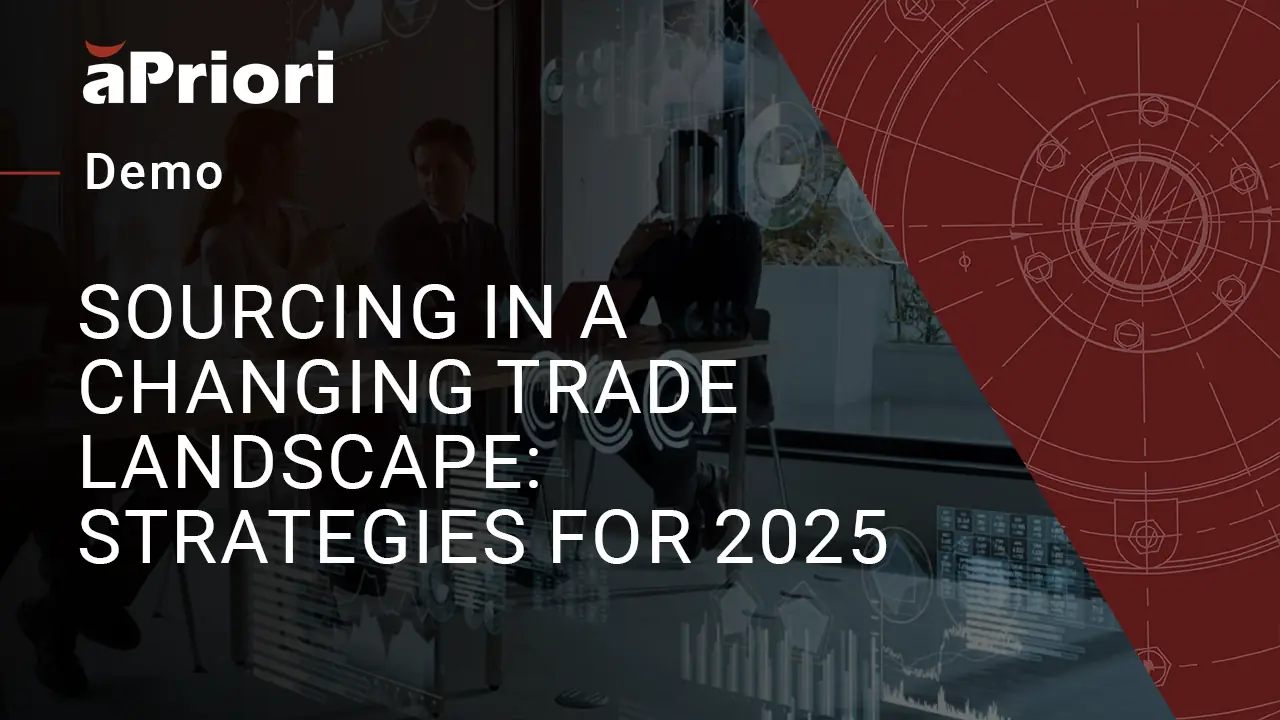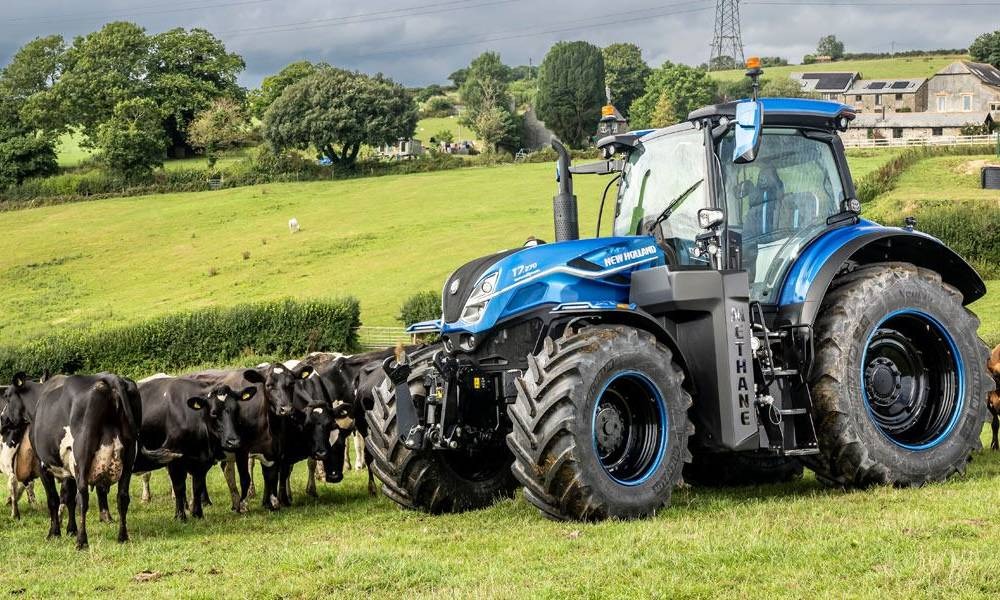Video
Sourcing in a Changing Trade Landscape: Strategies for 2025
Tariffs and trade regulation are unpredictable—but your mitigation strategy doesn’t have to be. In this video you will learn How to quickly assess and quantify tariff risks, strategies for supplier reallocation and cost mitigation, and the role of digital twins in scenario planning.

Transcript
Welcome to our demonstration on mitigating tariff implications, using aPriori. During this demonstration, you will understand how tariffs can impact your business, and bottom line, in real time. We’ll show you how to make smarter trade off decisions by aligning your sourcing strategies with your business goals and our data-rich product insights. We’ll help you prioritize your response to take immediate action where it matters most, and help build long-term strategies for resilience, as well as analyze your product portfolio at a high level, while diving into cost drivers, manufacturability challenges and carbon impact to improve decisions, negotiation, and getting you to market faster.
So let’s apply this to a real life example using our e-scooter.
Here are some of the business challenges that we can align our sourcing strategies to. The tariff and trade regulation into effect is imposing roughly 10 to 25% increase in tariff on imports to the US, from China, Canada, and Mexico. So we want to be able to understand the financial impact that that tariff will have on our production today, so we can make decisions for tomorrow.
How do we maintain that production for the demand that we have while still reducing costs? We have forecasted a strong demand for 2025. So how do we maintain our margins with increasing prices? Our forecasted growth is looking good at around 15%. So, how do we maintain that amid all of this disruption? And with shipping costs increasing, exploring production options closer to home seems like a good opportunity.
But is the cost to produce closer to home going to give us the return we’re looking for? Or is there another country that will offer us a better cost, or are customers are willing to pay today’s selling price? So, we need to find a way to limit increasing our price as much as possible. So, as a commodity manager for this product, how can we leverage aPriori to help us answer these questions and solve these business challenges?
If we take a look at today’s situation, we are selling the e-scooter for $267.06, with the cost of making the part today at $227, our current margins are around 15%, and we would like to maintain or grow those margins if we can. Last year, we had successful growth and are anticipating to increase our sales by roughly 15%. We currently have a global manufacturing footprint, and produce components in the US, India, Thailand, China and Mexico, with final assembly in the US.
However, with the tariffs imposed on the imports coming from China an additional 10%, and Mexico 25%, we need to evaluate the impact this will have on our margins and projected forecast. Customers today are willing to pay this price, but if we need to increase our costs above 10%, this willingness to pay will decline. So the first step in our process is to identify what countries are producing our components and where we have the most risk. By looking at this regional component cost report, I’m seeing that roughly 68% of my spend is in China and Mexico. This lets me know that there is some serious cost risk with the new tariffs in place.
When applying the tariff, you can see that this will exponentially increase our cost of goods sold. This is a first great step, but in order to make a decision on where to go next, I need more insight. If we run a comparison on the total cost to make the e-scooter, we see that it increases to $248.43 to make.
When we apply this to our projected forecasts for 2025, at the current selling price of $267.06, our margin would drop down to 7%, and we would potentially lose $2.73 in profit on every scooter we make. To maintain margins, that would mean we would need to increase the selling price by roughly 9% to $293.50, but we would still lose roughly $300,000 in annual profit in comparison to what we made in 2024.
This price increase could negatively impact our projected growth forecast, and we could potentially be pricing ourselves out of the market. So we need to quickly figure out how to address this to maintain our competitiveness in the market, meet our growth targets for 2025, and maintain margins. The act of moving components from one country to another has cost associated with it, and I’m not sure it makes the most financial sense to move all of my parts over.
So the next decision I have to make is which components should I prioritize first? I created two reports breaking down the cost of the components I produced in both China and Mexico. Breaking down the parts, we’ve identified several components impacting cost as the best candidates to prioritize relocating. Prioritizing the components that have the biggest cost impact will allow us to gain immediate cost reduction benefits without the burden of having to resource all of my components at once.
Taking a closer look at each component and the individual cost drivers I see our casting component has a higher material and labor cost. I also see that our brake washer has a high labor cost associated as well. Perhaps moving those parts to another country will lower that cost for us. These other parts coming out of Mexico have a high labor cost and direct overhead rate.
These are good qualifications for reshoring to a lower cost country. Using aPriori’s comparison feature, I can quickly see the fully burdened cost and piece part costs go up over 20%. So let’s take a look at moving production closer to home in the United States. In the US, it appears the labor costs, which were already high – an indirect overhead rates rise by nearly 400%.
So let’s take a look at moving production outside of North America to a lower cost country like Thailand. In Thailand, we’ve managed to reduce our costs from the original production in Mexico, from $17.88 to $9.51. We also see the material and labor rates have reduced significantly. By moving those initially identified components from Mexico and China to Thailand. The cost to make our e-scooter actually goes down from $248.43 (with the tariffs) to $218.55.
So not only were we able to quantify the potential cost impacts of the tariffs, but are able to use data to make decisions on where to relocate those parts and the impact that will have on our cost of goods sold. Now that we have a plan to mitigate some of the risk from the tariffs, are there other ways that we can mitigate the impact from the other components that we’re not able to relocate out of China or Mexico?
If we look at our cost outlier analysis, we can identify components with large gaps between what was quoted and our should cost. These outliers can offer us more opportunities for cost reduction. I’ve identified three components with significant gaps, and we’ll look to renegotiate these from the supplier. Similarly to the example before, I can dive deeper into what is driving the cost of these parts and use this as leverage during negotiations. To learn more about how to use should cost to drive fact based negotiations, check out our webinar on how to do that.
Looking ahead to some longer term strategies, I’ve also identified that the step assembly was way over our cost, weight, and carbon targets. I have flagged this as a VAVE project and kicked it off with our continuous improvement team. We have a full collaboration story about how we redesigned this deck. If you follow the QR code, we have the collaboration and design story mapped out there.
For a brief overview. Our original design was for smaller scale production in the US, but scaling into the EU, we needed a better option. Using aPriori, we were able to validate cost and carbon of various designs and approaches proactively. This led to bigger margin and smaller environmental impact. In a very short time, leveraging global asynchronous collaboration within aPriori, the team was able to share their expertise and departmental data earlier to facilitate a holistic design approach and enable agile development for this deck assembly. Asking what if questions, getting the answers from outside their own domains of expertise to develop the product faster, and then moving bottlenecks while elevating everyone’s role to a much more strategic one, we were able to reduce our cost and CO2 equivalent significantly for each iteration.
To summarize our actions, I was able to first identify the components that will have the most cost risk even before applying the tariff. After applying the tariff, I was able to confirm that the cost to make the part would increase from $225 to $248, driving our margins down to 7%.
From this, I was also able to quantify the potential financial loss. So in the short term, we were able to prioritize moving four parts out of China and Mexico. That would drive the greatest cost impact for us. We were able to dive into these components to determine what was driving these cost, material and labor. We compared alternative locations and reviewed what effect moving to a new location would have on material and labor, amongst other drivers like carbon.
This would further decrease our cost of goods sold from our original numbers. Since we were not able to move all parts out of China, we still have an increase in cost from tariffs. However, to lessen the impact, we ran a cost outlier analysis to see if there are any further gaps in quoted cost versus should cost, and we were able to identify three components with gaps larger than 40%.
This enabled us to go back to our China and Mexico suppliers to renegotiate based on the parts individual cost drivers. Of the gaps we identified, we were able to already renegotiate and realized 25% of that savings, equating to over $300,000. Also found in our outlier analysis was a VAVE project that we can kick off with our design engineers in the long term to meet our target cost and carbon goals.
The potential impact of this VAVE project would enable us to reduce the assembly cost by roughly $100 and reduce our carbon equivalent by 63kg. Every scenario run through aPriori platform adds value. Will something work? Will something be more expensive, more difficult to manufacture or have a higher global warming potential? The single set of data, a single source of truth within one platform, enables sourcing and procurement teams to ask those “what if” question, getting the answers from outside their own domain expertise to develop products faster, reducing risk and elevating everyone’s role to a much more strategic one.
Visit aPriori.com to learn more.

